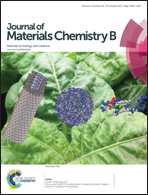Magnetic nanoparticle/polymer composites for medical implant infection control†
Abstract
New potential medical applications for magnetic nanoparticle/polymer composite coatings, including deactivation of bacterial biofilms, require much higher power densities than can be supplied by previously developed polymer composites. These coatings in turn require much higher nanoparticle concentrations, where particle–particle and particle–polymer interactions play a significant role in the material's performance. This paper investigates the effect of several key design parameters on the resulting specific absorption rate of magnetite nanoparticle composites. Hydrophobic (poly(styrene), (PS)) and hydrophilic (poly(vinyl alcohol), (PVA)) polymer composite coatings were compared in both aqueous and non-aqueous solvents at multiple nanoparticle loadings and film thicknesses. Heating rates up to 717 W g−1 Fe were observed in a typical (2.32 kA m−1, 302 kHz) alternating magnetic field (AMF), achieving heating power densities up to 7.5 W cm−2. To estimate in vivo power requirements, electrical resistance heating beneath a tissue mimic heat sink indicated a peak power requirement of only 4.5 W cm−2 to achieve an 80 °C surface temperature in 15 s, demonstrating that these composites can exceed the power densities needed for applications such as treating bacterial infections on medical implants in situ. Polymer identity, solvent identity, and especially orientation within the magnetic field were shown to strongly affect the power density with effects that are interrelated.


 Please wait while we load your content...
Please wait while we load your content...